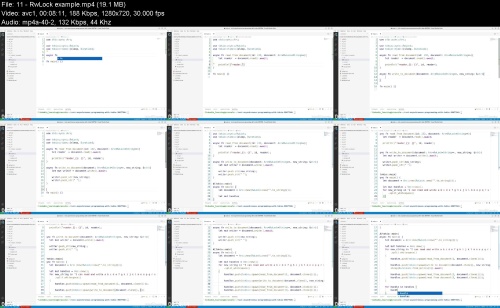Most Commented
Linkedin Learning Rust Asynchronous Programming with Tokio-iMPART




Description material

Linkedin Learning Rust Asynchronous Programming with Tokio-iMPART
Language: English | Size:166.07 MB
Genre:eLearning
Files Included :
01 - Use Tokio to put wasted CPU cycles to work.mp4 (3.69 MB)
MP4
02 - Exercise files.mp4 (2.27 MB)
MP4
01 - What is asynchronous programming.mp4 (3.17 MB)
MP4
02 - When to use asynchronous programming.mp4 (2.79 MB)
MP4
03 - How do the sync and await methods work in Rust.mp4 (3.07 MB)
MP4
01 - Tokio's asynchronous runtime.mp4 (3.1 MB)
MP4
02 - How to spawn a task.mp4 (3.56 MB)
MP4
03 - How to spawn a synchronous task.mp4 (3.24 MB)
MP4
04 - How to test asynchronous code.mp4 (2.53 MB)
MP4
05 - Spawning task example.mp4 (10.59 MB)
MP4
01 - What are asynchronous primitives.mp4 (4.93 MB)
MP4
02 - What is a mutex.mp4 (3.33 MB)
MP4
03 - Mutex example.mp4 (12.86 MB)
MP4
04 - What is a semaphore.mp4 (3.76 MB)
MP4
05 - Semaphore example.mp4 (14.49 MB)
MP4
06 - What is notify.mp4 (4.7 MB)
MP4
07 - Notify example.mp4 (13.51 MB)
MP4
08 - What is a barrier.mp4 (8.33 MB)
MP4
09 - Barrier example.mp4 (15.84 MB)
MP4
10 - What is RwLock.mp4 (3.29 MB)
MP4
11 - RwLock example.mp4 (19.1 MB)
MP4
01 - What are channels.mp4 (3.09 MB)
MP4
02 - Oneshot channel.mp4 (2.87 MB)
MP4
03 - Mpsc channel.mp4 (2.67 MB)
MP4
04 - Watch channel.mp4 (10.42 MB)
MP4
05 - Broadcast channel.mp4 (3.82 MB)
MP4
01 - Next steps.mp4 (1.03 MB)
MP4




Join to our telegram Group
Information
Users of Guests are not allowed to comment this publication.
Users of Guests are not allowed to comment this publication.
Choose Site Language
Recommended news
Commented


![eM Client Pro 9.2.1735 Multilingual [Updated]](https://pikky.net/medium/wXgc.png)






![Movavi Video Editor 24.0.2.0 Multilingual [ Updated]](https://pikky.net/medium/qhrc.png)

